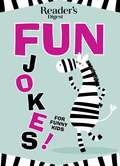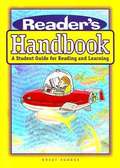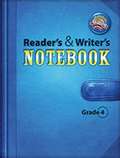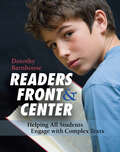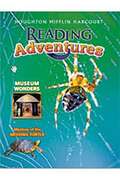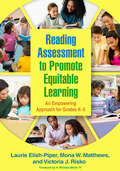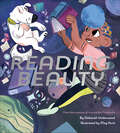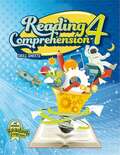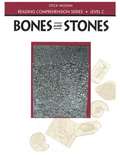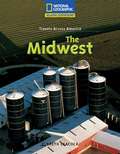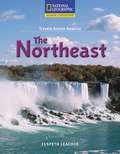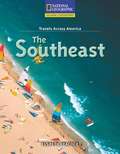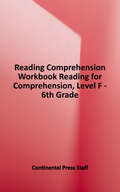- Table View
- List View
Reader's Digest Fun Jokes for Funny Kids
by Reader’s DigestWhere does a king keep his armies?... ...In his sleevies! Do you have a budding comedian on your hands? Loaded with Knock Knock jokes, riddles, one-liners, tongue twisters and puns, Fun Jokes for Funny Kids will give them hours of new material that will keep kids ages 6-12 rolling in laughter.Knock Knock jokes, riddles, tongue twisters and puns guaranteed to make your kids (and you) laugh out loud. Also includes illustrations and cartoons for extra giggles.
Reader's Digest Fun Jokes for Funny Kids Vol. 2
by Reader'S DigestWhy aren't dogs good dancers?... ...They have two left feet! Do you have a budding comedian on your hands? Loaded with Knock Knock jokes, riddles, one-liners, tongue twisters and puns, Fun Jokes for Funny Kids Vol. 2 will give them hours of new material that will keep kids ages 6-12 rolling in laughter.Knock Knock jokes, riddles, tongue twisters, one-liners and puns guaranteed to make your kids (and you) laugh out loud. Plus--Icon for Alexa's Favorites. Alexa is a 2nd grader from New York who loves telling jokes. She has hand-picked her favorites from each chapter. Knock Knock. ...Who's there? Dozen. ...Dozen who? Dozen anyone want to let me in? Knock Knock. ...Who's there? Pecan. ...Pecan who? Pecan someone you're own size! Why don't mummies take time off? ...They are afraid to unwind! Did you hear about the crook that stole a calendar? ...He got 12 months! What would bears be without bees? ...Ears! What travels all over the world but stays in one corner? A Stamp! How do turtles talk to each other? By using shell phones! Why are ghosts bad liars? Because you can see right through them! Why did the spider go to the computer? To check his web site. Where do polar bears vote? The North Poll.
Reader's Handbook, A Student Guide for Reading and Learning
by Laura Robb Phil Laleike Mike Mcconnell Margaret Ann Richek Vicki Spandel- In-depth understanding of the Before, During, and After reading process- Essential skills and strategies for a variety of materials and genres- Key comprehension tools, including notetaking, outlining, cause-effect diagrams, and double-entry journals- A resource for content area reading, supplemental reading activities, tutorials, and homework support
Reader's and Writer's Notebook [Grade 4]
by Pearson EducationNIMAC-sourced textbook<P><P> <i>Advisory: Bookshare has learned that this book offers only partial accessibility. We have kept it in the collection because it is useful for some of our members. To explore further access options with us, please contact us through the Book Quality link on the right sidebar. Benetech is actively working on projects to improve accessibility issues such as these. </i>
Reader, Grade 4, Unit 1: Personal Narratives, Childhood Memories
by Core Knowledge FoundationNIMAC-sourced textbook
Reader, Grade 4, Unit 2: The Middle Ages, Knights, Castles, and Chivalry
by Core Knowledge FoundationNIMAC-sourced textbook
Reader, Grade 4, Unit 6: Geology, The Changing Earth
by Core Knowledge FoundationNIMAC-sourced textbook
Reader, Grade 4, Unit 7: American Revolution, The Road to Independence
by Core Knowledge FoundationNIMAC-sourced textbook
Readers Front and Center: Helping All Students Engage with Complex Text
by Dorothy BarnhouseEvery teacher wants and expects his or her students to be reading increasingly complex texts, yet sometimes the gap between our expectations and our students' abilities seems wide and deep. It's tempting to look at that gap and step in to fill it for them, but then we'd be doing most of the heavy lifting the understanding, analysis, and interpretation that our students should be learning for themselves. So how can teachers reverse this trend and ensure that our students are fully entering, absorbing, and experiencing texts? How can we make sure they're making complex meaning independently and proficiently,- as the Common Core State Standards require? Readers Front & Center answers these questions by framing instruction that starts with the student. You'll learn how to do the following: Research and listen to your students so your teaching can be more targetedNotice and name your students' thinking so they can see- what complex thinking looks and sounds likeSet your students up to be problem solversPrepare your students to do increasingly complex thinking in increasingly complex texts Filled with examples of one-on-one conferences, small groups, and whole-class scenarios, this essential book provides an accessible and inspiring model of how-;and why-;we need to put students at the front and center of our teaching.
Reading 4 Christian Schools: I Met You In A Story (Second Edition)
by Dorothy BuckleyStories, poetry and folktales from around the world.
Reading Assessment to Promote Equitable Learning: An Empowering Approach for Grades K-5
by Victoria J. Risko Laurie Elish-Piper Mona W. MatthewsMany standard reading assessment approaches fail to capture the strengths and needs of students from diverse sociocultural, linguistic, and academic backgrounds. From expert authors, this book guides educators in planning and conducting meaningful, equitable assessments that empower K–5 teachers and students, inform responsive instruction, and help to guard against bias. The book's holistic view of reading encompasses areas from text comprehension and constrained skills to building trusting relationships and promoting students&’ agency. Twenty-eight assessment strategies are explained in step-by-step detail, including helpful implementation examples and 32 reproducible forms that teachers can download and print in a convenient 8 1/2" x 11" size.
Reading Beauty
by Deborah Underwood&“This modern retake on &“Sleeping Beauty&” is an interstellar fairy tale that is vibrantly illustrated and fun to read–aloud&” (School Library Journal).An irrepressible fairy tale retelling that is sure to charm readers of all ages: When a fairy&’s curse—a deathlike sleep via paper cut—threatens to make her kingdom barren of books, it&’s up to space princess Lex to break the spell and bring books back to her people. Set in the universe of the acclaimed Interstellar Cinderella, this empowering bedtime story for girls will entice young readers with its brave heroine, star-studded setting, and hilarious, heartwarming happy ending. Fans of Grown-Ups Never Do That and A Girl, a Racoon, and the Midnight Moon will also enjoy the fantastical storyline and captivating imagery found in Reading Beauty.Praise for Reading Beauty&“The rhyming text cleverly spins the story to involve reading at every turn. [And,] Hunt&’s mixed-media illustrations incorporate eye-pleasing sci-fi details.&” —Horn Book &“A nifty addition to the shelves of feminist fractured fairy tales.&” —Kirkus Reviews
Reading Comprehension 4 Skill Sheets
by AbekaThis workbook contains a full year of informative, narrative, and poetic selections designed for silent reading and evaluation. The activity sheets begin with recall questions for optional grading and build to critical thinking questions for recognizing and reinforcing literary concepts. <p><p>With this book, your students will develop essential reading skills and retain the important elements presented within a story.
Reading Comprehension 4: Skills Sheets
by Abeka BooksAssess your child’s reading comprehension skills throughout the year with Abeka’s Reading Comprehension 4 Skill Sheets. Poems, brief stories, and non-fiction passages are paired with activity sheets that give recall and critical thinking questions that will help your child build essential reading skills. Answers are located in the Reading Comprehension 4 Skill Sheets Teacher Edition (sold separately). 88 pages, softcover. Grade 4.
Reading Comprehension Series-Level C: Bones and Stones
by Martha K. Resnick Carolyn J. HyattConcentrates on sequentially building vocabulary and comprehension skills.
Reading Expeditions: The Midwest
by Linda HoytThe Midwestern region of the United States includes Minnesota, Wisconsin, Michigan, Nebraska, Ohio, Indiana, Illinois, Missouri, Iowa, Kansas, South Dakota, and North Dakota. Readers learn why the Midwest is flat and familiarize themselves with other features of the landscape as they tour the Great Lakes, the Ohio and Missouri Rivers, the Great Plains, the Badlands, and Wind and Jewel Caves. Students learn that the economy of the Midwest consists of "belts" from the Corn Belt to the Dairy Belt to the Manufacturing Belt.
Reading Expeditions: The Northeast
by Linda HoytThe Northeast region of the United States includes Maryland, Delaware, New Jersey, Pennsylvania, New York, Connecticut, Rhode Island, Massachusetts, Vermont, New Hampshire, Maine, and the District of Columbia. Land features of the Northeast region include coastal plains, rocky coastlines, and mountains. The Northeast economy depends heavily on the region's natural resources. Industries include shipping, timber, fishing, manufacturing, and tourism. Tourists to the Northeast region come to hike, swim, ski, camp, and to visit many historical and cultural sights, including the many Smithsonian museums in Washington, D.C.
Reading Expeditions: The Southeast
by Linda HoytThis guided tour helps students explore the Southeast, which includes the states of Kentucky, West Virginia, Virginia, Tennessee, North Carolina, South Carolina, Georgia, Alabama, Mississippi, Louisiana, Arkansas, and Florida. Students begin the tour looking at land and water features of the region--the Mississippi River and its delta, the Piedmont, Appalachian Mountains, and the coastal plains.
Reading For Comprehension: Level F
by Continental Press StaffHow does an IMAX movie work? With level F of Reading for Comprehension, your students will learn all about this kid-friendly topic and many more. This book for grade 6 students includes 46 high-interest, nonfiction articles with questions that reinforce key reading and writing skills commonly found on state tests. Multiple-choice questions test these reading skills: vocabulary, main idea and details, sequence, cause and effect, and inferences and conclusions. Students also answer open-ended questions to practice writing narrative text, descriptive text, persuasive text, and expository text.
Reading Instruction That Works, Fourth Edition: The Case for Balanced Teaching
by Michael Pressley Richard L. AllingtonThis widely adopted text and K-8 practitioner resource demonstrates how successful literacy teachers combine explicit skills instruction with an emphasis on reading for meaning. Distinguished researcher Richard L. Allington builds on the late Michael Pressley's work to explain the theories and findings that guide balanced teaching and illustrate what exemplary lessons look like in action. Detailed examples offer a window into highly motivating classrooms around the country. Comprehensive in scope, the book discusses specific ways to build word recognition, fluency, vocabulary, and comprehension, especially for readers who are struggling. New to This Edition *Updated throughout to reflect important recent research advances. *Chapter summing up the past century's reading debates and the growing acceptance of balanced teaching. *New and revised vignettes of exemplary teachers.

